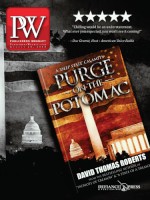Carey’s novel Little (Riverhead, Oct.)—also illustrated by the author—tells the story of a very small, very industrious girl who becomes the famous Madame Tussaud.
Why this particular subject?
I did visit Madame Tussaud’s as a child, and it was always terrifying (but in a way that I liked to be terrified). I remember seeing other traumatized children all about me. It was awful. It was wonderful. When I was older I took a job there, to stop people from touching the wax models. I used to keep very still and frighten the tourists by blinking or dropping a very quiet “hello” at them when their faces were up close, commenting on how realistic I was. It was there I learned that Marie Tussaud modeled (or said she modeled) Voltaire, Franklin, Louis XVI, the murdered Jean-Paul Marat, and that later she came to London and became famous in her own right. I remember standing next to her own model, dressed in Victorian bombazine, looking small and clever and toothless. She seemed wise and strange, a mythical character in her own right... can such a person really have done everything she said she did? She seemed like she’d dropped out of a Bruegel painting.
Did images and records of the historical characters in Little disturb your imagination as you were creating them?
Yes, enormously. I have never written about real people before (except for a Queen Victoria cameo). It was more than a little inconvenient to acknowledge the real facts of my characters’ lives. I had to do a great deal of research, which was wonderful, but also it’s impossible to read everything written, you’d drown. Researching Tussaud, it became apparent that she embellished her own life, so I began to relax a little and thought, “If she can make up her own life, then why can’t I make up her life”—of course always sticking to the principal facts. Drawing the characters, I had to be reasonably accurate (Napoleon, for example), but I could also make up characters—the Revolution was full of monsters—and drop them into the savagery. I didn’t want Marie to have parents—parents get in the way; like in fairy tales, it’s best to dispatch with parents as soon as possible.
Inanimate objects speak and have lives of their own. What inspired that?
I grew up in an old Tudor house in the east of England. The foundation was a Saxon hall. History was everywhere... all those other bodies that had inhabited the same space over so many hundreds of years. That house made many strange noises and seemed to be talking—only I wasn’t sure of the language. My family goes mudlarking on the banks of the Thames at low tide, where you can pick out of the mud small pieces of history, a clay pipe, a Tudor shoe, a bit of Roman tile. The Thames throws up its history every day, objects trying to bear witness to their lives.



 Volume 265
Issue 34
08/20/2018
Volume 265
Issue 34
08/20/2018





